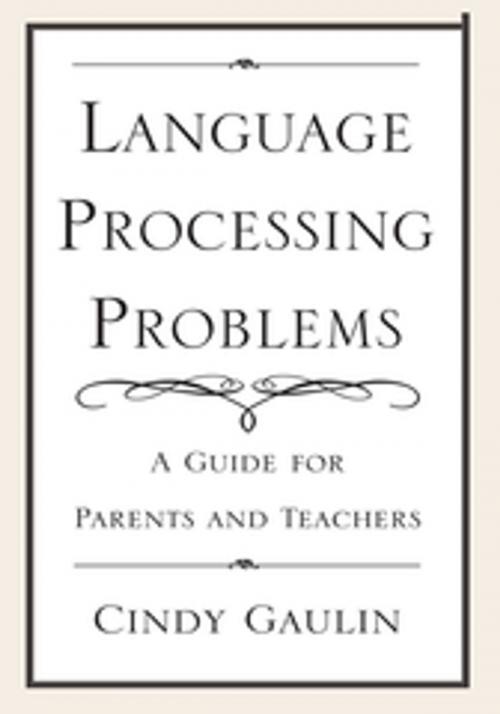Language Processing Problems
A Guide for Parents and Teachers
Nonfiction, Health & Well Being, Psychology, Child & Adolescent, Child Development| Author: | Cindy Gaulin | ISBN: | 9781462834617 |
| Publisher: | Xlibris US | Publication: | October 24, 2001 |
| Imprint: | Xlibris US | Language: | English |
| Author: | Cindy Gaulin |
| ISBN: | 9781462834617 |
| Publisher: | Xlibris US |
| Publication: | October 24, 2001 |
| Imprint: | Xlibris US |
| Language: | English |
Language Processing Problems: A Guide for Parents and Teachers is an easy-to-read but thorough treatment of a problem which is quite prevalent but often overlooked. Children (and adults) vary in their language processing capacities. Recognizing this variation can be very useful in understanding why certain children are having unexpected difficulties with school or social interactions. Split-second delays in recognizing words, problems remembering what was said, difficulties finding the word needed or organizing a complex sentence can all interfere with communication. For some children these problems are quite significant in spite of perfectly adequate or even exceptional knowledge of words and grammatical rules.
The book explains, in laymans terms, how people use language to communicate, the components of the language processing system and the types of problems that can arise with its use. In particular an attempt is made to discriminate between language processing problems and other disorders such as Attention Deficit Disorder (ADD), Central Auditory Processing Disorder (CAPD), Specific Language Impairment (SLI) and Dyslexia. Guidelines are provided for recognizing language processing problems and for deciding how to proceed toward a solution. The book ends with many suggestions which parents, teachers and children can use to address specific and general language processing problems.
A quick pass through the book finds that it begins with several examples of children who have language processing problems. It then provides down-to-earth descriptions of what language processing is and how we use speech to communicate. This is followed by discussions of the difference between language knowledge and language processing and other psycholinguistic topics such as word recognition and working memory. Distinctions are drawn between input and output processing and between auditory and visual language processing. These topics are followed by a chapter about how children learn to process language.
After this introduction to the workings of language processing, problems with language processing are treated in detail. What are the problems? Who has them? And what causes language processing problems? Confusions of terminology are dealt with and then come two chapters which lay out the intrinsic (genetic) and extrinsic (environmental) factors related to language processing problems. In these chapters I compare and integrate information about related problems which can co-occur or be confused with language processing problems.
The next two long chapters help parents and teachers recognize whether a child has a language processing problem and then decide what to do about it. The first of these chapters is divided into sections dealing with preschoolers, school-age children and high school students. The second chapter helps parents and teachers decide whether a speech-language evaluation is needed, what that evaluation should include, and details various possible treatment routes.
There are four chapters which provide suggestions for improving listening and following directions, verbal memory, word retrieval and organization of language output, respectively. In each chapter there are suggestions for external strategies (to be used by parents and teachers) and internal strategies (to be used by the child) as well as descriptions of the kinds of treatment available from speech-language pathologists for these problems.
A short, final summary is followed by a glossary and references.
Language Processing Problems: A Guide for Parents and Teachers is an easy-to-read but thorough treatment of a problem which is quite prevalent but often overlooked. Children (and adults) vary in their language processing capacities. Recognizing this variation can be very useful in understanding why certain children are having unexpected difficulties with school or social interactions. Split-second delays in recognizing words, problems remembering what was said, difficulties finding the word needed or organizing a complex sentence can all interfere with communication. For some children these problems are quite significant in spite of perfectly adequate or even exceptional knowledge of words and grammatical rules.
The book explains, in laymans terms, how people use language to communicate, the components of the language processing system and the types of problems that can arise with its use. In particular an attempt is made to discriminate between language processing problems and other disorders such as Attention Deficit Disorder (ADD), Central Auditory Processing Disorder (CAPD), Specific Language Impairment (SLI) and Dyslexia. Guidelines are provided for recognizing language processing problems and for deciding how to proceed toward a solution. The book ends with many suggestions which parents, teachers and children can use to address specific and general language processing problems.
A quick pass through the book finds that it begins with several examples of children who have language processing problems. It then provides down-to-earth descriptions of what language processing is and how we use speech to communicate. This is followed by discussions of the difference between language knowledge and language processing and other psycholinguistic topics such as word recognition and working memory. Distinctions are drawn between input and output processing and between auditory and visual language processing. These topics are followed by a chapter about how children learn to process language.
After this introduction to the workings of language processing, problems with language processing are treated in detail. What are the problems? Who has them? And what causes language processing problems? Confusions of terminology are dealt with and then come two chapters which lay out the intrinsic (genetic) and extrinsic (environmental) factors related to language processing problems. In these chapters I compare and integrate information about related problems which can co-occur or be confused with language processing problems.
The next two long chapters help parents and teachers recognize whether a child has a language processing problem and then decide what to do about it. The first of these chapters is divided into sections dealing with preschoolers, school-age children and high school students. The second chapter helps parents and teachers decide whether a speech-language evaluation is needed, what that evaluation should include, and details various possible treatment routes.
There are four chapters which provide suggestions for improving listening and following directions, verbal memory, word retrieval and organization of language output, respectively. In each chapter there are suggestions for external strategies (to be used by parents and teachers) and internal strategies (to be used by the child) as well as descriptions of the kinds of treatment available from speech-language pathologists for these problems.
A short, final summary is followed by a glossary and references.















